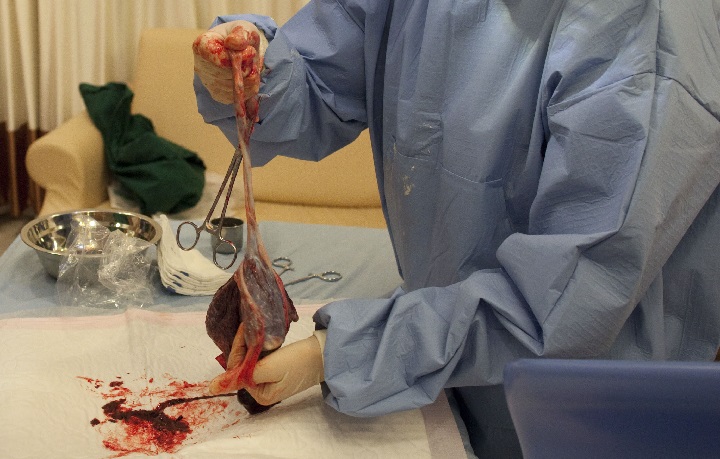There’s no evidence eating your placenta is a good idea, but that isn’t stopping women from doing it.

The placenta develops in the uterus during pregnancy. It provides oxygen and nutrients to the growing fetus while removing the embryo’s waste products.
Eating the placenta after giving birth, called placentophagy, has been practiced for millennia but has become a particularly trendy topic in the past several years.
Placenta-munchers claim the practice has a number of positive effects, including easing postpartum depression and relieving pain.
It looks like a large, 500-gram dark red organ encased in a sac. Some people eat it tossed in a smoothie or cooked in a stir fry.
And, lately, many women pay to have their afterbirth made into capsules.
READ MORE: Top 5 weird celebrity parenting tips
Some big names are buying in. Members of the Kardashian clan and actors January Jones, Gabby Hoffman and Alicia Silverstone all rave about the positive effects of consuming the placenta as new mothers.
Evidence lacking
This discussion is not new in the scientific world. But most of the research has involved animals, not humans.
Most mammals — including some herbivores such as cows — consume the placenta after giving birth. A study published in 1980 explored hypotheses of why they do — sheer hunger? Nutritional benefits? Cleaning the birthing area? Preventing predators from getting a whiff of their presence? It could be all of the above.
A 1954 study in which women having difficulty breastfeeding after giving birth were fed either freeze-dried placenta or beef found that 86 per cent of women who consumed placenta showed improved milk production and flow, compared to a 33 per cent improvement in the women who consumed the beef.
READ MORE: Got baby brain? Forgetfulness during pregnancy is all in your head: study
But don’t get too excited: A 2012 study found those findings are too flawed to allow for meaningful conclusions.
That 2012 study, Placentophagia in Humans and Nonhuman Mammals: Causes and Consequences, published in the journal Ecology of Food and Nutrition, states that because most people don’t feel compelled to chow down on their placentas, must be a “good adaptive reason for its elimination.”
“Placentophagia, particularly if the afterbirth materials are raw, may have negative biological effects for some humans. Therefore subjecting participants to placentophagia may incur harm and yield few meaningful data.”
Translation: Don’t try this at home, or in human experiments.
The study concludes that science should figure out what benefits consuming placenta can have and essentially mimic them it in a lab instead.
A 2015 review out of Northwestern University concludes there are no proven health benefits to eating placenta. But there are unknown risks.
Researchers noted zero regulations for handling or storing of the placenta before consumption and inconsistent dosing.
“There are a lot of subjective reports from women who perceived benefits, but there hasn’t been any systematic research investigating the benefits or the risk of placenta ingestion,” corresponding study author Dr. Crystal Clark wrote in the report.
“The studies on mice aren’t translatable into human benefits.”
Women swear by it anyway
Tatiana Plechenko isn’t a scientist or a doctor. But she’s convinced placentophagy helped her get back to normal after experiencing low energy and mood swings after giving birth. And now she runs a successful business in the Ottawa area turning clients’ afterbirths into consumable products.
“All the feedback that I’ve had has been absolutely positive. People praise it so much.”
Plechenko, a former doula, now stays home with her two children while running her business, Ottawa Placenta. She says her services are often booked months in advance as parents prepare for their new arrivals.
READ MORE: ‘Miracle baby’ born encased in amniotic sac
The service offers what Plechenko calls a “traditional Chinese” method that involves steaming the placenta before dehydration, or a raw method where the placenta is not cooked before dehydration.
It’s then pulverized and placed in capsules — you get about 70-200 (depending on the size your placenta) pills starting at $190 per order. She also offers a fresh smoothie containing raw placenta alongside a woman’s pill order, which she says offers a big boost to new mothers.
“I’ve found that the smoothie is the most potent after the birth,” Plechenko said. “Those were the mums where I saw the most changes postpartum.”
Plechenko says a client who tried placentophagy for the first time after her third pregnancy told her the difference was undeniable.
“She said ‘It was such a difference, I will do it for as long as I’m having kids.'”
Plenty of other women agree.
A 2010 survey of 189 women found that 76 per cent reported a positive experience with placentophagy after giving birth. The top three positive effects reported were improved mood, increased energy and improved lactation. The results were published in the journal Ecology, Food and Nutrition in 2013.
“Our survey participants generally reported some type of perceived benefit from the practice, felt that their postpartum experience with placentophagy was a positive one, and overwhelmingly indicated that they would engage in placentophagy again after subsequent pregnancies,” the authors wrote.
Yummy placenta smoothie
Ingredients:
- 1 cup berries (strawberries, raspberries or cherries)
- 1 banana
- 1 tbsp raw honey
- 100ml purified water
- 20g raw placenta
Recipe courtesy of Tatiana Plechenko



Comments